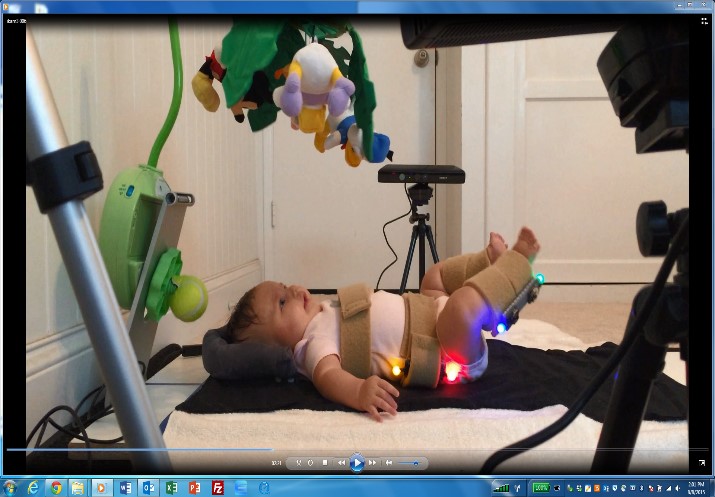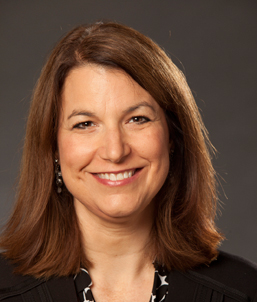Accelerating a Scientist's Quest to Develop New – and Earlier – Treatments for Cerebral Palsy
USC researcher Barbara Sargent thinks kids with cerebral palsy can make bigger strides against the movement disorder with the right therapy, so she's working to identify and treat the condition much earlier than previously thought possible.
Newborns with cerebral palsy (CP) move in much the same way as typical babies--flailing, kicking and wiggling as they learn to use their arms and legs. That's why the neurological movement disorder is usually not noticed or diagnosed until one or two years of age.
And though treatment and rehabilitation may begin immediately after diagnosis, therapists typically miss the chance to take advantage of an important early period of brain and neural development, according to Barbara Sargent, PhD, PT, PCS, Assistant Professor of Clinical Physical Therapy, USC Division of Biokinesiology and Physical Therapy, and a scholar supported by a career development grant from the Southern California Clinical and Translational Science Institute (SC CTSI.)
CP is a neuromuscular disorder that stems from problems in early brain development or from some type of insult or injury to the brain, explained Sargent. Preterm infants can also be at high risk for the condition. It causes abnormal movement, and can make it impossible for those with the condition to walk normally, or at all.
Harnessing the natural neuroplasticity of babies
Sargent believes more can be done to help kids with CP attain more normal motor abilities by diagnosing the condition earlier and starting physical therapy that takes advantage of babies' neuroplasticity--their natural powers of neuromuscular growth and development.
"Babies have a huge aptitude for neuroplasticity, but very few researchers have studied such young children," said Sargent. "Most CP research is done with older children that already have a diagnosis."
To speed her efforts to investigate these questions through clinical research and develop new types of interventions for CP, Sargent applied to the SC CTSI for an Institutional Development Award, a career growth fellowship that provides training specific to clinical and translational science, to help early-career scientists obtain major research funding and become successful principal investigators.
The SC CTSI award and training, Sargent said, has helped her sharpen her clinical and translational research skills, giving her valuable insights into subjects such as study design, team science and grant applications -- skills that will not only improve the quality of her research, but also support her long-term goals as a clinical investigator.
"I think what the CTSI is really giving me is a bigger picture of research," said Sargent. "As scientists, we tend to become siloed in our own disciplines, but to be more competitive in grants, to work effectively in teams, and to do clinical and translational research well, you really need the kind of skills the SC CTSI covers in its education and training."
For Sargent's CP research, a central challenge is to diagnose the disorder in the earliest months of life--when the kids may appear fine, even to the trained eye.
Sargent studies infants three months and younger, "before the age that there is a diagnosis of CP," she said. Her chief clinical research goal is to develop therapeutic interventions that will help infants with CP develop more normal movement and abilities as they grow up. But research with babies has unique challenges.
Sargent conducts this research with colleagues at the Development of Infant Motor Performance Laboratory (DIMPL), established for research and rehabilitation of babies with motor issues. The lab is also collaborating with motor development researchers in Germany and Japan.
"It's difficult to determine an appropriate task for a 3-month-old, so it's critical to design the research appropriately so you can document that the intervention is causing the change, and not some other factor," said Sargent.

Identifying interventions for the youngest patients
Sargent and the other DIMPL researchers use various technologies--including an interactive mobile that infants can learn to control with their own movements--to study motor learning and interventions. By placing lights on the babies' legs and trunk to collect and track movement data, the researchers are hoping to spot telltale signs of CP. The same technology is being used therapeutically, to help infants at high risk for CP push their limits and expand their movement skills.
"The SC-CTSI has been critical in helping me design the study to say that the changes we observe are happening as a result of our intervention," said Sargent.
Experts at SC CTSI also helped Sargent improve her ability to explain her research to people outside her area. "This makes it possible to appeal to broader aspects of society and medicine, which expands the pool of grants we can pursue," she said.
The Clinical and Translational Research (CTR) Scholar Program is a three-year program created to support research career development for health professionals or individuals with research doctoral degrees who wish to pursue formal training and a career in clinical and translational research. The SC CTSI Workforce Development (WD) group (formerly Education, Career Development, and Ethics-ECDE) has funding through the National Institutes of Health (NIH), to award up to four Clinical and Translational Research (formerly KL2) candidates every year.




